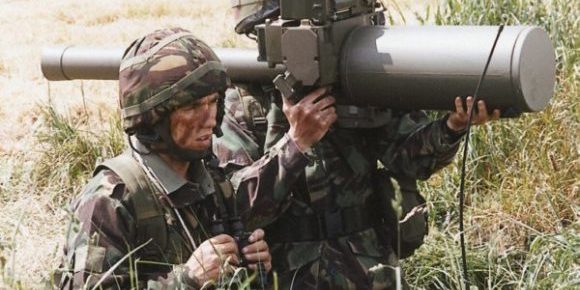Quick Facts
| Variants |
Submarine Launched Airflight Missile (SLAM) Javelin Starburst |
| Role and Mobility |
Short-Range Surface-to-Air Missile; Man- Portable (MANPAD) |
| Interceptors and Range | 2.2 kg high explosive or shaped charge; 3.5 km |
| Sensors |
Yagi antenna for transmitting guidance systems Semi-automatic guidance using manual command to line of sight (MCLOS) |
| Targets | Fast, Low-Flying Aircraft |
| Status/Exports | Operational; Afghanistan, Chile, Ecuador, Guatemala, Israel, Malawi, Malaysia, Nigeria, Oman, Portugal (replaced by FIM-92 Stinger), Qatar, Thailand, UAE |
| Designer/Producer | Thales Air Defence Limited |
Overview
The Blowpipe is a short-range surface to air missile designed to intercept low flying aircraft. It was first produced in the United Kingdom in 1975 and has since been exported to several countries around the globe. While the United Kingdom replaced the Blowpipe with the Starstreak missile system in 1985, other countries continue to deploy the Blowpipe as a part of their short-range air defenses.[i]
For guidance, the Blowpipe uses semi-automatic action while the missile clears the launcher, then an MCLOS (“Manual Command Line-Of-Sight”) guidance system is activated. MCLOS allows the operator to track the missile to the target via a small controller on the launch unit while utilizing the included optics for aiming/tracking. Detonation of the missile could be through a contact fuse or proximity fuse method with the intent to cause enough damage to a speeding aircraft so as to bring it down.[ii]
The Blowpipe system is of a unique design, with a wide front section and a thin tube behind it. This is because the fins used to steer the missile are packed into the front section while the rest of the missile is at the rear end of the tube. When the missile is fired, the fins slide into place on the missile and are sealed to the missile through a heating method.[iii]
A few variants of the Blowpipe were designed:
Submarine Launched Airflight Missile (SLAM): A submarine-launched variant of the Blowpipe, it was deemed a failure soon after entering service and was subsequently retired[iv]
Javelin: An improved variant to the Blowpipe with better flight performance and a Semi-Automatic Command to Line of Sight (SACLOS) control system. (The Javelin variant of the Blowpipe missile is unrelated to the United States’ FGM-178 Javelin)[v]
Starburst: An advanced version of the Javelin that used semi-active laser guidance to improve the control system[vi]
Strategic Implications
The Blowpipe was strategically valuable following its development as the missile became the popular air defense weapon to combat increasing speeds in aircraft.[vii]Its light weight made it portable by a single soldier, which also made it operable in a wide variety of environments.
Timeline
1993: Production of the Blowpipe ends[viii]
1985: The United Kingdom retires the Blowpipe[ix]
1975: Development is completed, and production begins[x]
1974: HMS Aeneas is decommissioned and no more orders for SLAM were made[xi]
1972:SLAM is added to the HMS Aeneas in an evaluation capacity[xii]
1966:Development begins[xiii]
Recent News
References
[i]http://www.military-today.com/missiles/blowpipe.htm
[ii]https://www.militaryfactory.com/smallarms/detail.asp?smallarms_id=794
[iii]http://www.military-today.com/missiles/blowpipe.htm
[iv]Ibid.
[v]Ibid.
[vi]Ibid.
[vii]https://www.militaryfactory.com/smallarms/detail.asp?smallarms_id=794
[viii]http://www.military-today.com/missiles/blowpipe.htm
[ix]https://www.militaryfactory.com/smallarms/detail.asp?smallarms_id=794
[x]http://www.military-today.com/missiles/blowpipe.htm
[xi]Ibid.
[xii]Ibid.
[xiii]Ibid.

